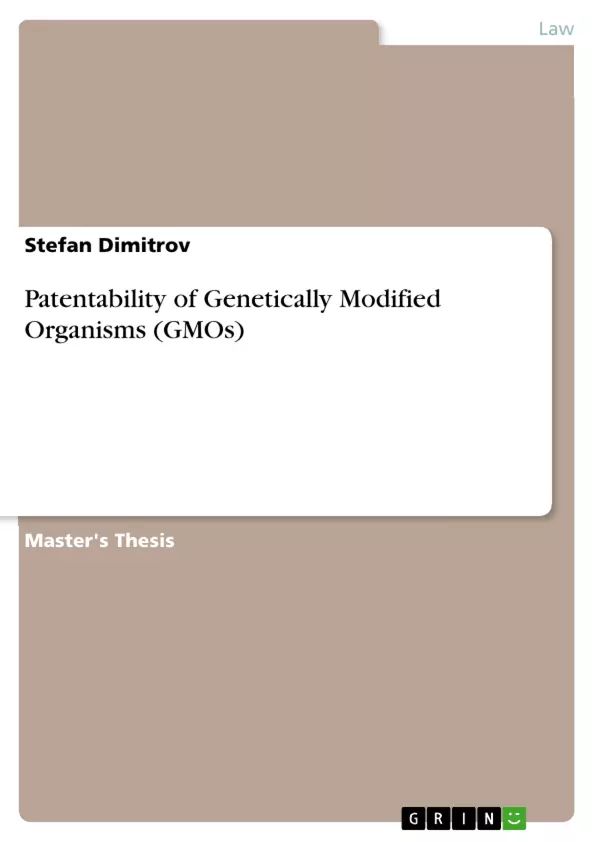The discovery of the double- helical structure of DNA in 19532 has led to an exponential growth of related new technologies and has generated enormous financial research costs3. To accumulate these sums the biotech industry is particularly motivated by the attraction of patent protection4. Patent regimes have been challenging boundaries between human invention and nature and have become an important and controversial tool for protecting biotechnological knowledge. The issues covered range from patenting of gene sequences5 from lower organisms such as bacteria up to higher life forms as living animals6. Patent practice has become increasingly broad7.
One of the jurisdictions still strong enough to resist the Western trend to extend the coverage of new-life forms is surprisingly Canada being the neighbour to the most inventive U.S. biotechnological industry8. Subject of this work are GMOs destined for marketing on global level, i.e. foodstuff and agricultural products9 but pharmaceuticals and other products as well as far as natural ingredients are concerned. Myriads of novel GMOs could be developed and released into the global environment to help to solve severe shortages or problems in agriculture, energy or medicine by providing more and better food, alternative fuel or new and more effective pharmaceuticals10. The debate is fuelled by unfulfilled expectations concerning the ongoing WTO round, statements of NGO activists11 and new projects of multinational corporations and more intense in Europe than in North America.
TABLE OF CONTENTS
- Patentability of Genetically Modified Organisms
- Chapter I
- Introduction
- Expectations aimed at promising new products
- Interdependencies of investment and innovation
- Access to GM-products – rethinking the role of patents?
- GM-patentability as precondition to solve global nutrition problems?
- Chapter II
- Setting the stage: Definitions and who are the players
- Genetically Modified Organisms
- Biotechnology
- Plant breeding
- Producers and markets for patents on GMOs
- Primary producers' product range
- Animals
- The front against GM-patents
- GMOs and the food supply chain
- Obligations
- Chapter III
- Range of biotechnological activity challenging intellectual property law
- Aberrations in patent practice
- The Human Genome Project
- Cloning of the human body
- Patenting medical procedures
- Plant breeders' rights and the \"right to food\"
- Biopiracy
- Examples
- Summary
- Chapter IV
- Ethics and morality of law
- Ethical considerations on bio-engineering
Objectives and Key Themes
This dissertation explores the patentability of genetically modified organisms (GMOs) in the context of intellectual property law and its evolving role in the life sciences. It examines the complex interplay between innovation, investment, and access to GMOs in addressing global challenges, particularly in food security. The work seeks to understand the legal framework governing GMO patentability, analyzing international instruments, practices, and controversies.
- The evolving role of patents in the life sciences and the commercialization of research.
- The relationship between intellectual property protection, innovation, and access to GMOs.
- The legal and ethical considerations surrounding patenting life forms, including human and plant genomes, cloning, and medical procedures.
- The implications of GMO patentability for biodiversity, food security, and the "right to food."
- The need for a balanced approach that addresses both the potential benefits and risks of GMO technology.
Chapter Summaries
- Chapter I: Introduction This chapter sets the stage for the dissertation by outlining the expectations, challenges, and potential implications of GMO technology. It examines the crucial role of patents in promoting innovation and investment in biotechnology, while considering the potential impact on access to GMOs and its implications for global nutrition.
- Chapter II: Setting the stage: Definitions and who are the players This chapter provides a comprehensive overview of GMOs, biotechnology, and the various stakeholders involved in the development and commercialization of these technologies. It also discusses the different producers and markets for patents on GMOs, exploring the complexities of the food supply chain and the role of international obligations.
- Chapter III: Range of biotechnological activity challenging intellectual property law This chapter delves into the specific challenges posed by biotechnology to existing intellectual property frameworks. It examines key areas of debate, including patenting the human genome, cloning, medical procedures, plant breeders' rights, and biopiracy. The chapter provides examples and summarizes the emerging legal landscape.
Keywords
This dissertation focuses on the central themes of patentability, genetically modified organisms (GMOs), intellectual property law, biotechnology, ethics, and global food security. It examines the current legal framework governing GMOs, including international conventions and agreements, as well as the challenges posed by this technology to traditional notions of patentability and the ethical considerations involved in patenting life forms. Other key concepts include the "right to food", biopiracy, and the role of international institutions in regulating GMOs.
- Arbeit zitieren
- Stefan Dimitrov (Autor:in), 2002, Patentability of Genetically Modified Organisms (GMOs), München, GRIN Verlag, https://www.grin.com/document/13628



